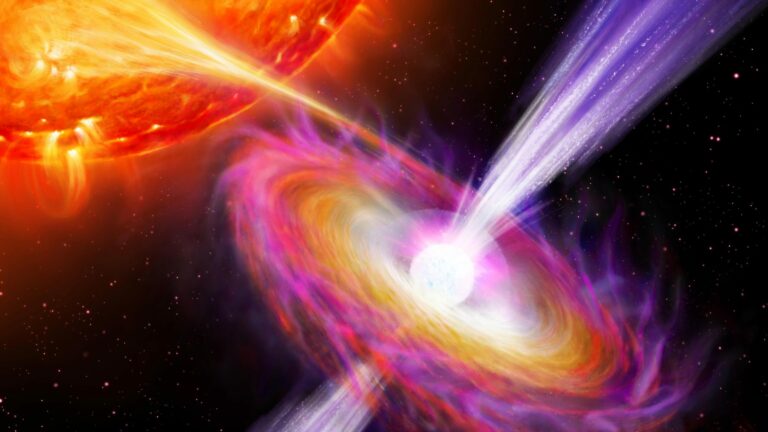New Discovery Reveals Stellar Jets’ Incredible Speeds for the First Time “Cosmic Cannibals”
A recently performed experiment that was published in Nature has equally enabled astronomers to gauge the velocity of gas jets in space. The studied jets were emitted by the “cosmic cannibals”, meaning stars producing these, and go at the rate of over a third of the speed of light. In this case, the research, initiated by the detonation of nuclear explosions on the surface of stars via the aid of electron positrons, has opened the door to new perspectives about these wild processes. Jakob van den Eind, a Warwick Prize Fellow at the Department of Physics of the University of Warwick and co-author of the study, noted that the huge explosions are the central focus of the research group who investigated neutron stars as they are well known for their enormous gravitational pull not less than that of the black holes.
Detailed Mechanism of Jet Formation
The hydrogen source stemming from a companion sun closer to the gravitationally-collapsed matter grows into spiral form encircling the collapsed star, resembling a snowing in nature. Whereas more of the stuff is falling, the gravitational strength finally prevents an explosion when the infinitesimal particles get packed together. This jets’ eruption exerts pressure on the material that is being drawn inwards, letting particles out at speeds that are very high.
The scientists devised a procedure of analyzing the characteristics of jets and speed of the jets by comparing X-ray signals registered by the Australia Telescope Compact Array operated by CSIRO (Australia Science Organization) and the Integral satellite operated by ESA. Co-Author Thomas Russell from the National Institute for Astrophysics, INAF, Palermo, Italy, stated: “The experiment enlightened us with knowledge of the phenomenon. We found a fleeting presence of new material throughout the jet that made it possible for us to monitor the motion of the jet and also to determine the speed. “
This artistic animation illustrates how nuclear explosions on a neutron star feed the jets blasting off from its magnetic polar regions. When in orbit with another star, the neutron star’s intense gravitational field can ‘suck’ material away from the nearby companion. The material swirls towards the collapsed object, circling it, forming a disk, and ultimately plunging to the surface. The crashing gravity on the neutron star’s surface violently compresses the accumulated material (consisting mostly of hydrogen) causing a runaway nuclear explosion. This in turn triggers the jets to suddenly intensify and eject particles into space at very high speed. Credit: ESA – European Space Agency Acknowledgments: D. Futselaar and N. Degenaar, University of Amsterdam. Work performed by ATG Medialab under contract with ESA
Observational Challenges and Results
Jakob van den Eijnden stated: “The supernovae eruptions appear randomly, which makes their time of occurrence quite unpredictable. Therefore, we hope that by observing the sky with the telescope for long periods, we would be able to catch a few of them. During three days, we were lucky enough to see ten eruptions and jets stretching over the sky.
The jets were traced travelling with an incredible velocity of approximately 70,700,000 kilometers per second which is equivalent to speed 35-40% of the speed of light.
This seminal discovery was one for the first time history has seen, it prophesized and directly prove how gas is being fed into a jet and boost in to space.
Nathalie Degenaar, co-author from the University of Amsterdam, the Netherlands, added: “Preliminary evidence showed that a huge blast would remove the rocket site at the launch pad of the jet. Yet, unexpectedly, we found that the explosion generated greater formation of jet rather than destruction. “
The researchers assert that both the mass and the rotation of the neutron stars and black holes are an indispensable mechanisms for developing the jets.
This work is more than a proof of concept test, it will be treated as a model for future studies on neutron stars and their outflows. Jets may also be fired up by supernova explosions and high-energy eruptions of gamma-ray bursts. These new data will probably partly reconfigure the design of Universe studies.
Reference: “Thermonuclear explosions on neutron stars reveal the speed of their jets” by Thomas D. Russell, Nathalie Degenaar, Jakob van den Eijnden, Thomas Maccarone, Alexandra J. Tetarenko, Celia Sánchez-Fernández, James C. A. Miller-Jones, Erik Kuulkers and Melania Del Santo, 27 March 2024, Nature.
DOI: 10.1038/s41586-024-07133-5
Do not forget to share your opinion with us to provide you with the best posts !




0 Comments